Cubanite is a relatively common constituent of sulphide mineralization containing copper. For instance, most people think that all of the copper recovered in the giant Sudbury mining area is from chalcopyrite. It has been estimated that, actually, up to 15% of the copper recovered, originates from cubanite in the ores. The ores are composed of massive sulphides and the cubanite occurs as masses or as crystals frozen in chalcopyrite and pyrrhotite.
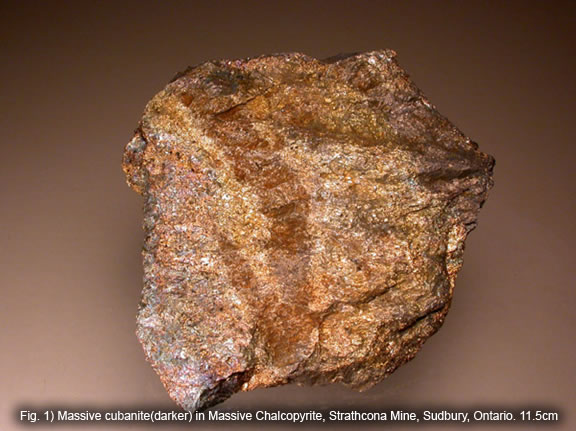
Probably other occurrences of massive cubanite are overlooked because cubanite is mistaken for chalcopyrite. In massive form, they look fairly similar and a simple chemical analysis would show copper, iron and sulphur just as you would expect from chalcopyrite..... if you weren't expecting something different.
Although massive cubanite is fairly common, well crystallized crystals of cubanite, are relatively rare and are much sought after. Most collections, even major institutional collections, have well crystallized cubanite from, perhaps, only a few localities. The author was surprised to come across well crystallized specimens from seven different localities within Canada.
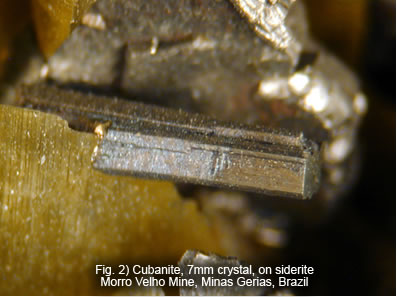
The various localities exhibit a broad diversity of morphology from equant, to prismatic, to acicular as well as twinned and untwinned. Such a broad range of morphology is not what most people expect of cubanite. Most people think of cubanite as the tabular, twinned crystals typical of Chibougamau, Quebec or the Sudbury area. It is true that somewhat elongated crystals are known from Morro Velho (Fig. 2) but they are fairly rare and not well represented in private collections.
Cubanite has such a diversity of habits that there could very well be cubanite crystals in many collections that have, before now, been mistaken for other minerals. The purpose of this article is to draw attention to the various forms, geological environments and mineralogical assemblages that well formed cubanite crystals have been found in and, hopefully, to stimulate analysis of specimens in collections. This will probably cause more localities to be discovered and result in specimens being identified properly.
Henderson II Mine, Chibougamau, Quebec
History: Cubanite from the Henderson No. 2 Mine is well known and the occurrence has been well recorded (Levesque, 1983). We will not go into detail here other than to say that the Henderson No. 2 Mine was reported closed (Levesque, 1983) in 1982 but in fact, the mine reopened again in 1984, then closed again in 1989. Additional specimens were recovered during that time.

Geology: The ore at the Henderson No. 2 Mine occurs in a shear zone and subsidiary fractures in altered anorthosite. According to Levesque(1983) there are numerous faults that are parallel to or cut across the main ore zone. Some of the shear zones are open and contain euhedral crystals of cubanite and other minerals.
Minerals: There are a number of different minerals in the open shears and according to Levesque (1983), they include calcite, cubanite, pyrite, sphalerite and siderite. Pyrrhotite and quartz have also been observed by the author.
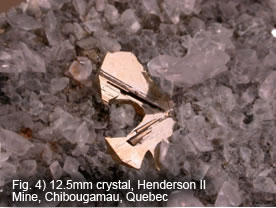
The Henderson No. 2 Mine is the source of some of the world's best cubanite crystals. It has also been the most prolific with many excellent specimens recovered over the years. Most major collections have a Chibougamau cubanite in them. The crystals are often very sharp and unusually large with crystals being reported up to 3cm across. In addition, the lustrous brassy yellow colour contrasts with white calcite crystals or a plain coarse massive pyrite making the specimens a visual delight.
The crystals that occur at the Henderson No. 2 Mine all seem to be twinned and excellent photographs appear in Levesque, 1983,. Crystals are often “sixlings” composed of three intergrown crystals (figs. 3 &4). Some crystals appear to be twins composed of two members twinned on (110) (fig. 5).
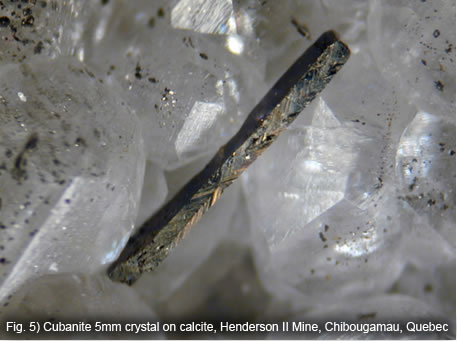
Strathcona Mine, Sudbury, Ontario

History: The Strathcona mine is a large underground Ni/Cu mine operated by Xstrata (formerly Falconbridge Inc.), near Sudbury at Levack, Ontario and has run continuously since 1969. In the past, excellent crystals of cubanite have been found at the mine and they include some of the largest examples of this mineral. The production of specimen grade pieces, though, has not been prolific in recent years. Cubanite crystals have also been found at the Frood Mine in the past (Peacock and Yatsevitch, 1936), also associated with the Sudbury Igneous Complex but none have been recovered in recent years, to the best of our knowledge.

Geology: Much has been written about theorebodies associated with the world famous Sudbury Igneous Complex. Briefly, the complex of rocks intruded into a meteoric impact site. Subsequent cooling of the magma formed discrete layers including quartz norite at the base, gabbro and then a granophyre cap (Naldrett, Rao, Evenson, 1986). During cooling and subsequent events, bodies of massive sulphides were formed and modified. There was much post intrusion metamorphism and subsequent movement of rocks as the complex cooled and contracted forming shear zones and faults.
Minerals: Cubanite crystals are usually found associated with calcite and pyrrhotite. The crystals are, generally, of equant to tabular habit and almost always twinned. They rival the Chibougamau crystals as the worlds finest and probably were the best until the specimens from the Henderson II mine began to emerge (Photo of ROM large crystal). There is an excellent photograph of a micro crystal from this locality in V. Anderson's "Microminerals" column in the Mineralogical Record, Vol 13, p. 109.

Thompson Mine, Thompson, Manitoba
History: The cubanite occurrence at Thompson, Manitoba is the Thompson Mine orebody of INCO Limited's (now Vale-Inco) Manitoba Division. The Thompson Mine has been operating since 1959 and is currently the main source of ore for the fully integrated Nickel-Copper mining/milling/smelting and refining complex at Thompson.
The actual occurrence of the cubanite crystals has not been well documented since the few specimens existing were recovered by surveyors and miners during cut and fill mining operations in the 1980’s. The best crystals appear to have been recovered from the T-l shaft workings at the west end of the orebody (pers. comm. Mr. P. Babulic). More recently, in the 1990’s, small cubanite crystals were collected at the T-3 mine workings (1C orebody) at the east end of the ore bearing zone. Currently, the mining method is highly mechanized, using large open stopes, not the cut and fill stopes where the best crystals were originally found. With this mining method, miners rarely actually see the ore in situ. The only time that it is possible to observe freshly blasted ore or rock is during development of the top and bottom sills of the stopes or the associated development work and therefore the odds of finding specimen grade crystals are low.

Geology: The Thompson Nickel orebody is one of several in the Thompson Nickel Belt. The Thompson Nickel Belt is a linear tectonic feature on the boundary of the Superior and Churchill geological provinces in North Central Manitoba (Pederery et al, 1982). There are a number of rock types in the belt but most of the Ni/Cu sulphide deposits are associated with serpentinites and the rocks that host them; the metasediments and gneisses.
Minerals: The ore at Thompson occurs in various configurations but mineralogically consists of, largely, pyrrhotite and pyrite with smaller amounts of massive pentlandite, chalcopyrite, millerite, cubanite, small amounts of sphalerite with various silicates and, as well, several carbonates. There are localized high arsenic areas which contain gersdorfite and nickeline. Well crystallized sulphides, with the exception of pyrite and millerite, are extremely rare at the mine.
The cubanite at T-3 mine occurs in a vuggy shear zone, outside the orebody, with euhedral quartz, calcite rosettes, sphalerite and minor millerite. It is felt that the minerals in the shear were probably derived from the adjacent orebody and the country rock, remobilized into the shear then deposited during a period
of metamorphism.
History: The Nigadoo River Mine was located near Robertville in Gloucester County, New Brunswick. It was an underground lead-zinc-copper mine in the mid 1960's to the mid 1970's. The author has observed cubanite crystals on only one specimen attributed to this mine.
Geology: The Nigadoo River Mine's orebodies were veins that cut both Silurian sediments and the Nigadoo porphyry. The origin of the veins has not been precisely determined. It is felt (Suensilpong & Stumpfl, 1971) that they could have been derived from the porphyry or parent magma at depth. Alternatively, they were remobilized from deeper deposits during and/or after the intrusion of the porphyry or its parent magma.
Minerals: The specimen carrying the cubanite crystals is not characteristic of the mine's ore. It is composed of scalenohedral calcite crystals speckled with pyrrhotite and cubanite. We do not know what part of the mine the specimen came from or if it came from within the ore veins themselves. It could have come from associated mineralization in the country rock. An interesting feature of the crystals is that they appear to be untwinned. Fig. 10, 11 & 12).
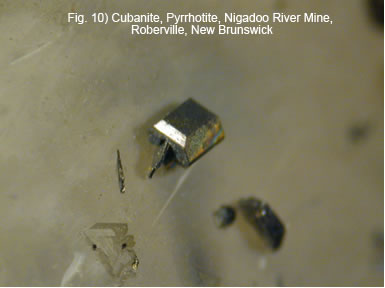
Although the crystals were originally thought to be millerite, the authors suspected that they were not. A simple magnet attraction test on a crystal pried from the matrix proved that they were not millerite and were more likely cubanite. Subsequent x-ray analysis carried out at the Royal Ontario Museum confirmed the suspicion.
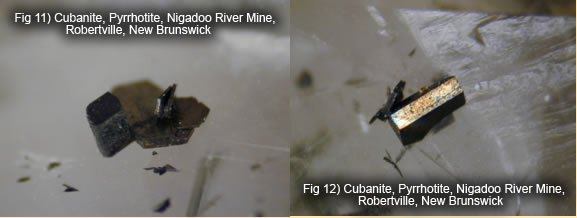
Silvana Mine, Sandon, British Columbia
History: The Silvana Mine started producing silver-lead-zinc ores and concentrates early in the last century and has operated off and on again through 1999. Exploration work continues today and the mine is currently operating, again, with ore being milled at the Sandon mill of Klondike Silver Corporation, the current owner of the mine.
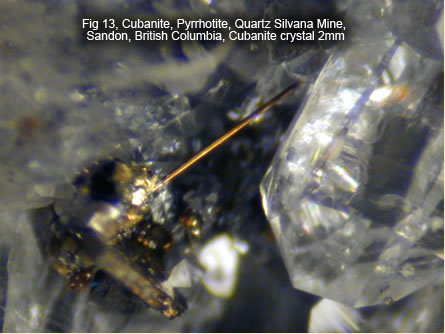
Robert Attridge, a former technician at the mine prior to 1992, occasionally collected some micro crystals of various minerals while employed at the mine. Eventually some of these specimens came to the attention of Mark Mauthner, then a student at the University of British Columbia (UBC). The cubanite crystals were initially unidentifued and were subsequently identified by EDS and x-ray diffraction techniques at UBC by Mauthner.
Geology: The Silvana Mine orebodies occur associated with a lode structure in folded, overturned, argillaceous sediments. It is theorized that the orebodies were remobilized from the main original lode into smaller adjacent structures during a period of tectonic activity. That period also caused graphitization and some brecciation. There are open spaces in tension gash-fractures and shear planes (personal comm. R. Attridge) that contain the crystals of interest.
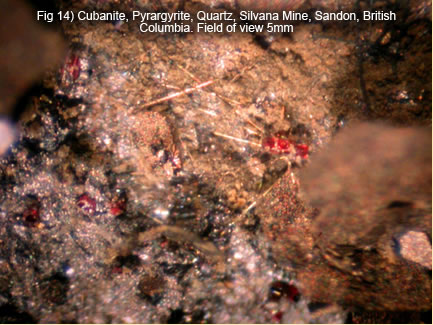
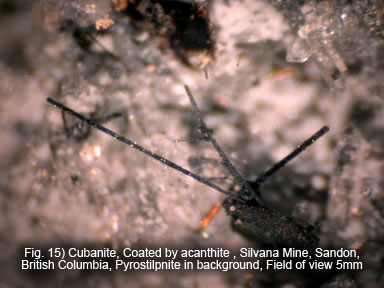
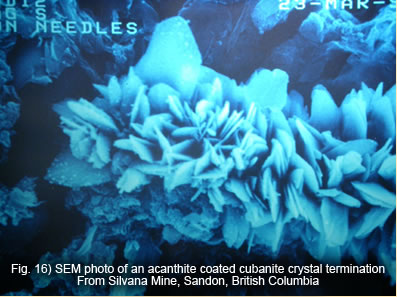
Minerals
Cubanite was one of the last minerals to crystallize in the orebody. The specimens observed contain crystals of cubanite, usually less than 2mm, associated with pyrrhotite, pyrargyrite, pyrostilpnite, quartz, sphalerite, galena, calcite and a chlorite-like mineral. Bladed acanthite crystals were found coating cubanite crystals on one specimen (figs. 15 and 16).
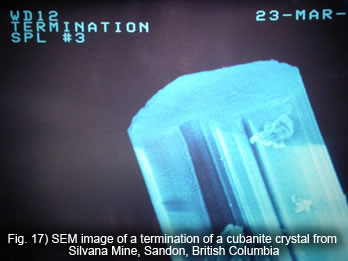
The morphology of the cubanite is unusual in that the crystals are elongated with a very high length to width ratios compared to the "classic" crystals that we are used to seeing. They are deeply striated prisms elongated on {001} and are terminated by simple pinacoid c (Fig. 17). The prism faces are rounded and when in combination with the deep striations the crystals appear "ropey". They are also unusual in that there are no signs of twinning when scrutinized under the SEM.
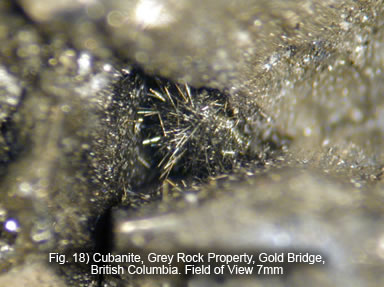
History: The Gray Rock Property is located near the headwaters of Truax Creek at between 6500 and 6800 feet above sea level near Gold Bridge, British Columbia. The property is of interest because of the quartz veins that are present. These veins were originally explored for precious metals back in 1936 but were never extensively mined. The specimens containing cubanite crystals were originally recovered by Lloyd Twaites, a well known Vancouver collector, and avid hiker. Another collector, Ty Balacko (White Rock, BC), noted strange, elongated, metallic crystals amongst the other minerals and subsequent analyses identified the crystals as cubanite. The analyses were accomplished by Dr. R. Boggs of Eastern Washington University.

Geology: The quartz veins occur in metamorphosed sediments in close proximity to the Bendor Batholith, a uniformly medium-grained granodiorite (Annual Report of the Minister of Mines of the Province of British Columbia, 1936)
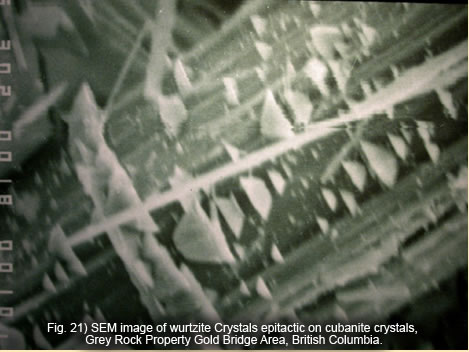
Minerals: The cubanite is a late forming mineral in the veins and is relatively rare. Other associated species include quartz, stibnite, tetrahedrite, chalcopyrite, sphalerite, galena realgar, pararealgar, bournonite and pyrite.
The crystals are elongated on {001}, are tapered and occur both as radiating tufts and as individual crystals less than 2mm in length mostly on or partially embedded in pyrite and quartz. The individual crystals appear to be composed of prism faces, prominent because of the elongation on {001} and are terminated by a simple pinacoid (001). Many of the crystals diverge into multiple terminations.
Advocate Mine, Baie Verte, Newfoundland
History: The asbestos mine at Baie Verte is located 6km north of Baie Verte. Mining and production of asbestos fibre began in 1963 and operated with a couple of short interruptions until 1991. The Advocate Mine was a large open pit mine that produced 5000 tons per day of ore plus several times that amount of waste rock each day. The final pit dimensions are approximately 1500m long and 500km wide with a depth of 300 metres.
The specimens of cubanite from the Advocate Mine were originally collected by the author during 1978. They were originally thought to be millerite because of their high length to width ratio and colour and resided in his collection as that mineral for many years. In 1990, a specimen was given to R. Gault at the Canadian Museum of Nature at Ottawa and x-ray analysis revealed that the crystals were cubanite.
Geology: The Advocate Mine is located in the Advocate ultramafic body. The orebody is a serpentinized peridotite and probably formed under conditions similar to those of other asbestos mines in eastern Canada. In short, the highly fractured peridotite acted as a conduit for serpentinizing fluids. The fluids derived magnesia and silica from wall rocks and eventually crystallized out as chrysotile in the fractured, serpentinized host rock.
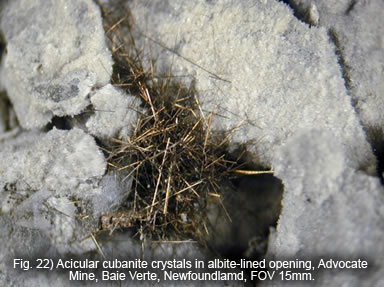
The cubanite appears to have crystallized in a small area believed to be a fracture zone in the altered mafic volcanics or volcaniclastics just outside the contact with the south side of the complex. Because of the location and the genesis of the ore, it is felt that the filling was post-ore deposition. It was exposed on the south, final wall of the open pit.
Minerals: The cubanite is associated with pyrrhotite, calcite, albite, a brown chlorite mineral and a fibrous silicate. The crystals of cubanite have extremely high length to width ratios, longer than that seen from any other locality. They resemble very fine millerite! The size is usually microscopic but crystals up to 10mm in length were found.
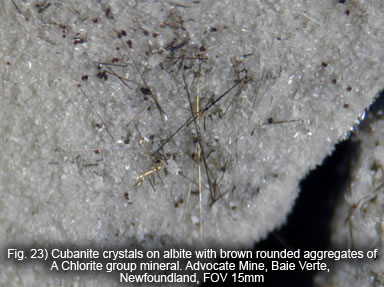
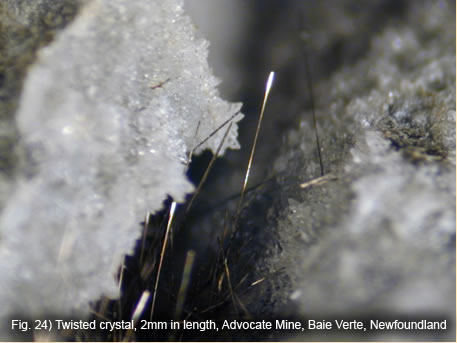

Like the other localities with acicular cubanite, using SEM imaging, the crystals appear to be untwinned with either square or rounded cross sections with prism faces predominating. Terminations appear to be either very flat or obscure. The crystals are deeply striated, so much so, that they sometimes appear to be composed of members in parallel growth.
Some crystals appear to be twisted in a fashion similar to other minerals that exhibit twists due to “screw dislocation” during formation.
In addition to the cyclic twinned habit that cubanite is usually associated with, we have shown that there are additional habits that would not be normally associated with cubanite. The acicular habits from the Advocate Mine and the Silvana Mine are particularly dramatic examples of this type of morphology. The tapered, elongated habit seen from the Grey Rock Property also is atypical compared to the habits normally expected for the mineral.
There is a test that will help greatly to differentiate cubanite from other minerals such as millerite or chalcopyrite – simple magnetism. Cubanite is relatively highly magnetic and a loose crystal will readily cling to a magnet. With small crystals, this phenomenon is easily observed under the microscope. With a sensitive, suspended magnet, crystals of cubanite may be detected while on matrix. Of course, the presence of pyrrhotite or magnetite, which are often present in sulphide ores, would render such a method ineffective and a suspect crystal or fragment should be detached from the matrix if those minerals are thought to be present.
There were many people who assisted the author with the work involved in assembling this article on cubanite from Canada. Although the work was conducted in the 1990’s and many people have changed jobs, retired, or passed on, I would like to thank them all in the present context. Many thanks to those who provided specimens and information from some of the previously unknown localities; the Silvana Mine, Mark Mauthner and Robert Attridge; the Gray Rocks property, Lloyd Twaites and Ty Balacko; T-1 Mine, P.Babulic; Nigadoo River Mine, Dr. P. Von Bitter.
Many thanks to Dr. George Robinson currently curator at the A.E. Seaman Museum, Houghton, Michigan, formerly of the Canadian Museum of Nature for help with SEM analysis and photography of specimens. R. Gault and the late J. van Velthiusen of the Canadian Museum of Nature provided the first X-ray analysis of the Advocate Mine cubanite. Thanks to Malcolm Back of the Royal Ontario Museum for help with x-ray analysis and, both he and Kathy David, for SEM photography. W. Ridley, formerly of ICI Explosives Canada generously assisted with EDS analytical and SEM photographic support. Dr. R. Gait provided very valuable help in researching information and discussion of contents. Lloyd Twaites, Mary Simpson and Malcolm Back helped greatly with improving the contents and quality of the text. Dr. R. Woodside provided valuable guidance and insight into the structure and morphology of cubanite.
SZYMANSKI, J.T. (1974) A Refinement of the structure of Cubanite, Zeitschrift fur Kristallographie, Bd.140, S218-239
ANNUAL REPORT of the MINISTER of MINES of the PROVINCE of BRITISH COLUMBIA (1936), F43-F47
BEALES, F.W. and LOZE, G.P. (1975) Sudbury Basin sediments and the meteoric impact theory of origin for the Sudbury structure, Canadian Journal of Earth Sciences, Volume 12, 629-635
HIBBARD, J. (...?) Geology of the Baie Verte Peninsula PALACHE, C., BERMAN, H. and FRONDEL, C. (1951) Dana's System of Mineralogy, 7th edition, John Wiley and Sons, New York
NALDRETT, A.J., RAO, B.V. and EVENSEN, N.M. (1986)
Contamination at Sudbury and its role in ore formation, in Metallogeny of Basic and Ultrabasic Rocks (lnstitute of Mining and Metallurgy), 75-91
LEVESQUE, A. (1983) Cubanite from Chibougamau, Mineralogical Record, May-June, 151-154
PEACOCK, M.A. and YATISEVITCH, G.M. (1936) Cubanite from Sudbury, Ontario, American Mineralogist. Volume 21, 55-62
PEREDERY W.V. and Geological Staff (1982) Geology and Nickel Sulphide Deposits of the Thompson Belt, Manitoba, in: Precambrian Sulphide Deposits (Special volume 25), Geological Association of Canada, 165-209
SOMMERS, R.E. and WALKER, J.F. (1954) Lode Metals in British Columbia. Report of the Minister of Mines, British Columbia Department of Mines. A104-A105
SUENSILPONG, S. and STUMPFL, E.F. (1971) The Nigadoo River base metal deposit, New Brunswick, Canada, Transactions of the Institution of Mining and Metallurgy, 95-104
TRAILL, R.J. (1983) Catalogue of Canadian Minerals, Geological Survey of Canada, Paper 80-18, 124-125